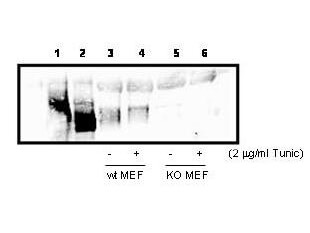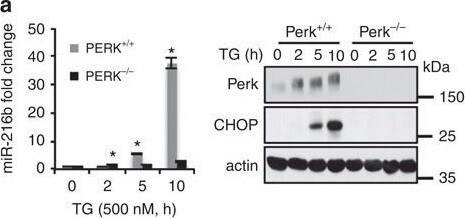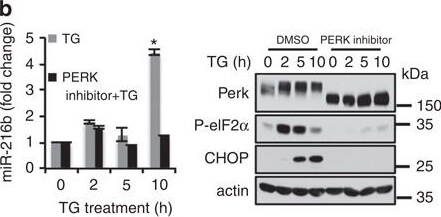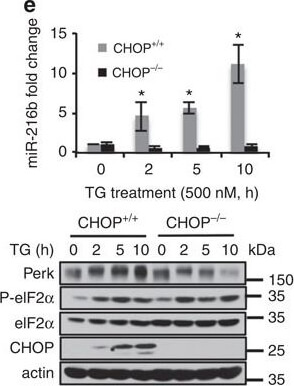Datasheet is currently unavailable. Try again or CONTACT US
PERK Antibody
Rabbit Polyclonal
9 References
100-401-962
100 µL
Liquid (sterile filtered)
WB, IHC, IP, Other
Mouse
Rabbit
Shipping info:
$50.00 to US & $70.00 to Canada for most products. Final costs are calculated at checkout.
Product Details
Anti-PKR-like Endoplasmic Reticulum Kinase (PERK) (RABBIT) Antibody - 100-401-962
rabbit anti-PKR-like Endoplasmic Reticulum Kinase Antibody, rabbit anti-PERK Antibody, PKR-like endoplasmic reticulum kinase, PERK, Eukaryotic translation initiation factor 2-alpha kinase 3
Rabbit
Polyclonal
Antiserum
Target Details
Eif2ak3 - View All Eif2ak3 Products
Mouse
Recombinant Protein
This whole rabbit serum was prepared by repeated immunizations with a recombinant fusion protein from amino acids 601-1115 of mouse deltaN PERK.
This antiserum is directed against PERK and reacts with the PERK from mouse tissues. Reactivity to other species is unknown.
Application Details
IHC, IP, WB
Other
- View References
This antiserum has been tested for use in western blotting, immunoprecipitation and immunohistochemistry. Specific conditions for reactivity should be optimized by the end user. Expect bands approximately 150kDa by western blotting in the appropriate cell lysate or extract.
Formulation
80 mg/mL by Refractometry
0.02 M Potassium Phosphate, 0.15 M Sodium Chloride, pH 7.2
0.01% (w/v) Sodium Azide
None
Shipping & Handling
Dry Ice
Store vial at -20° C prior to opening. Aliquot contents and freeze at -20° C or below for extended storage. Avoid cycles of freezing and thawing. Centrifuge product if not completely clear after standing at room temperature. This product is stable for several weeks at 4° C as an undiluted liquid. Dilute only prior to immediate use.
Expiration date is one (1) year from date of receipt.
The PKR-like endoplasmic reticulum kinase (PERK, also know as Eukaryotic translation initiation factor 2-alpha kinase 3) is a type I transmembrane protein localized to the endoplasmic reticulum (ER). PERK consists of an N-terminal ER luminal domain, a membrane-spanning region, and a cytosolic C-terminal serine/threonine kinase domain (1). The luminal domain of PERK is bound to the ER chaperone GRP78 in unstressed cells (2). PERK activation occurs upon accumulation of misfolded proteins and the ER lumen, which triggers GRP78 dissociation from PERK thereby allowing PERK dimerization and autophosphorylation (3, 4). PERK phosphorylates two established targets: the eukaryotic translation initiation factor 2 alpha (eIF2, (1)) and the Nrf2 transcription factor (5). Phosphorylation of eIF2 results in attenuation of translation initiation (6). The translational block also contributes to cell cycle arrest due to loss of the G1 regulatory protein, cyclin D1 (7). PERK-dependent phosphorylation of Nrf2 promotes transcription of phase II detoxifying enzymes which is critically important for elimination of intracellular reactive oxygen species (8). Thus, while inhibiting new protein synthesis and thereby decreasing the ER protein load PERK simultaneously induces expression of genes that help restore cellular redox homeostasis and promote survival.
Goyon V et al. (2023). MAPL loss dysregulates bile and liver metabolism in mice. EMBO Rep.
Applications
WB, IB, PCA
Srinivasan MP et al. (2022). Exposure to binge ethanol and fatty acid ethyl esters exacerbates chronic ethanol-induced pancreatic injury in hepatic alcohol dehydrogenase deficient deer mice. Am J Physiol Gastroinest Liver Physiol.
Applications
Undefined
Srinivasan MP et al. (2020). Activation of AMP-activated protein kinase attenuates ethanol-induced ER/oxidative stress and lipid phenotype in human pancreatic acinar cells. Biochem Pharmacol.
Applications
WB, IB, PCA
Kaphalia L et al. (2019). Ethanol exposure impairs AMPK signaling and phagocytosis in human alveolar macrophages: Role of ethanol metabolism. Alcohol Clin Exp Res.
Applications
WB, IB, PCA
Xu Z et al. (2019). Linking dysregulated AMPK signaling and ER stress in ethanol-induced liver injury in hepatic alcohol dehydrogenase deficient deer mice. Nat Commun.
Applications
WB, IB, PCA
Maekawa et al. (2018). ATF7 mediates TNF-α-induced telomere shortening. Nucleic Acids Research
Applications
WB, IB, PCA
Howley et al. (2018). A CREB3-regulated ER-Golgi trafficking signature promotes metastatic progression in breast cancer. Oncogene
Applications
WB, IB, PCA
Xu et al. (2016). miR-216b regulation of c-Jun mediates GADD153/CHOP-dependent apoptosis. Nature Communications
Applications
WB, IB, PCA
Mukhopadhyay et al. (2016). Casitas B-cell lymphoma (Cbl) proteins protect mammary epithelial cells from proteotoxicity of active c-Src accumulation. Proc. Natl. Acad. Sci. U.S.A
Applications
WB, IB, PCA
This product is for research use only and is not intended for therapeutic or diagnostic applications. Please contact a technical service representative for more information. All products of animal origin manufactured by Rockland Immunochemicals are derived from starting materials of North American origin. Collection was performed in United States Department of Agriculture (USDA) inspected facilities and all materials have been inspected and certified to be free of disease and suitable for exportation. All properties listed are typical characteristics and are not specifications. All suggestions and data are offered in good faith but without guarantee as conditions and methods of use of our products are beyond our control. All claims must be made within 30 days following the date of delivery. The prospective user must determine the suitability of our materials before adopting them on a commercial scale. Suggested uses of our products are not recommendations to use our products in violation of any patent or as a license under any patent of Rockland Immunochemicals, Inc. If you require a commercial license to use this material and do not have one, then return this material, unopened to: Rockland Inc., P.O. BOX 5199, Limerick, Pennsylvania, USA.





